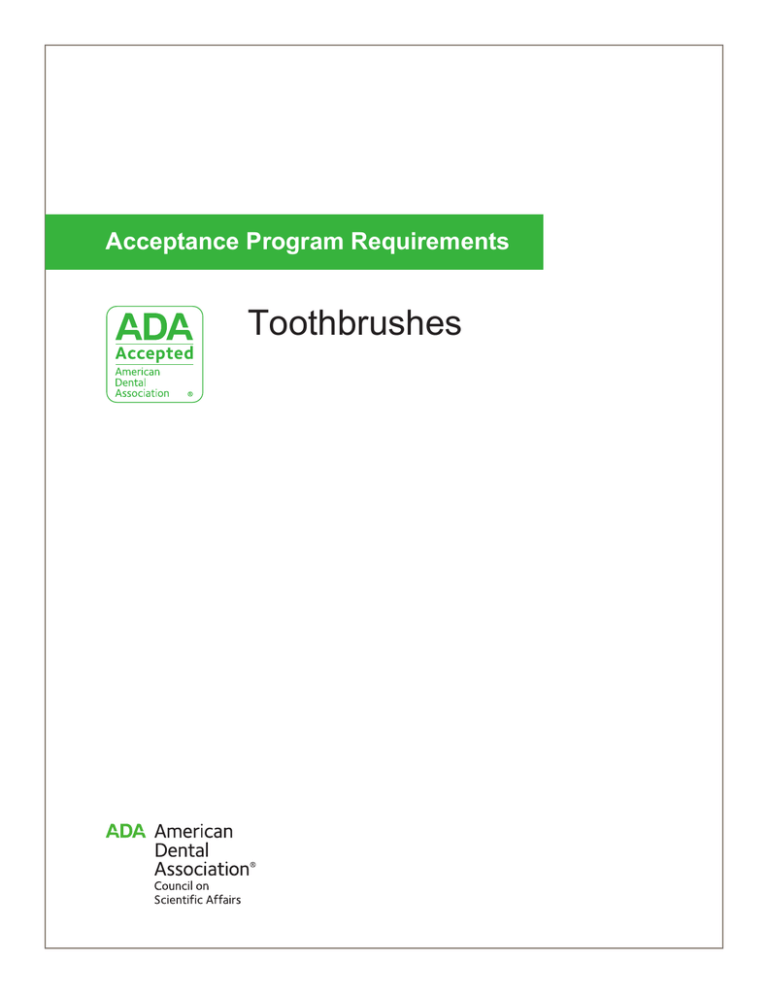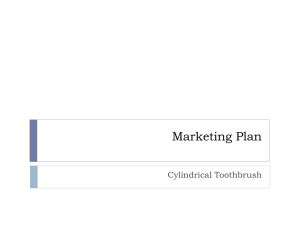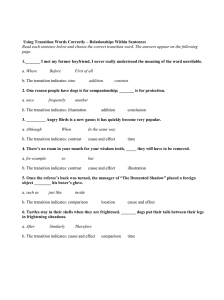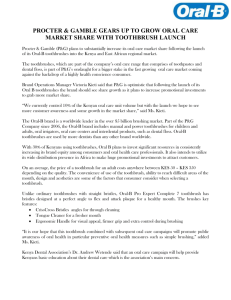
Acceptance Program Requirements
Toothbrushes
Acceptance Program Requirements
Toothbrushes
Council on Scientific Affairs Toothbrushes
Purpose:
The Acceptance Program applies to over-the-counter dental
products for which safety and efficacy has been established by
laboratory and/or clinical evaluations where appropriate.
Accordingly, the purpose of these requirements is to provide a
structure upon which toothbrushes can be considered for ADA
Acceptance.
Scope:
These guidelines apply to the design of clinical trials and other
information needed to evaluate the safety and efficacy of
manual and powered toothbrushes intended for the removal of
dental plaque and the reduction of gingivitis.
NOTICE REGARDING SUBMISSION OF COPYRIGHTED MATERIALS
To make the review of submissions to the ADA Acceptance Program as efficient as possible, the Council on Scientific Affairs
provides copies of submitted materials to Council members and consultant reviewers, and also posts submitted materials to an area
of the ADA's website the access to which is restricted to Council members and staff.
BY MAKING A SUBMISSION, YOU ARE REPRESENTING AND WARRANTING TO THE COUNCIL ON
SCIENTIFIC AFFAIRS AND THE ADA THAT YOU HAVE OBTAINED SUFFICIENT PERMISSION(S) FROM
THE COPYRIGHT OWNER(S) OF ANY COPYRIGHTED MATERIAL INCLUDED WITH YOUR SUBMISSION
TO ALLOW FOR THE PUBLICATION AND DISTRIBUTION OF THAT MATERIAL BY THE ADA DESCRIBED
ABOVE, AND AGREE TO INDEMNIFY AND HOLD ADA HARMLESS FROM ANY AND ALL CLAIMS ARISING
FROM SUCH PUBLICATION OR DISTRIBUTION.
If you have questions, please contact 312.440.3528.
Acceptance Program Requirements: Toothbrushes
April 2016
I.
SUBMISSION DIRECTIONS
A. Submissions are to be sent in electronic format (CD, flash drive, or email) to the
Council Office:
Acceptance Program
Council on Scientific Affairs
American Dental Association
211 East Chicago Avenue
Chicago, Illinois 60611-2637
adaseal@ada.org
B. The submission fee is a one-time, non-refundable fee and is required before review
begins. Maintenance fees are billed to the company in January of every year.
C. Notification of Council action on a submission will vary depending on whether a
submission must be reviewed by the Council at one of its two annual meetings, or if it
can be reviewed by an e-mail ballot.
• Council meeting = approximately 2-4 weeks following the Council meeting
• E-mail ballot = approximately 4-6 weeks following receipt of a complete
submission
More time may be required if additional information or clarification is needed from the
manufacturer.
D. When a product is classified as “Accepted” and is awarded the ADA Seal of
Acceptance, the Acceptance period is 5 years. Manufacturers will be contacted
approximately 6 months before the expiration of the current Acceptance period to
complete the requirements for the next 5 year Acceptance period.
E. Classification of a product under the Acceptance Program is subject to the conditions
stated in the Agreement Governing Use of ADA Seal of Acceptance.
II. INFORMATION TO BE SUBMITTED
1. Product Information
A. Name of product(s)
B. Name of company
C. Evidence of FDA approval to market 1, if applicable (e.g., 510 (k) letter, pre-market
approval, NDA).
D. Claims of safety and efficacy
i. List all claims of safety and efficacy, including all health benefit claims and all
claims which imply a health benefit, must be documented.
ii. The Council believes that because plaque is the etiologic agent for gingivitis
and other oral diseases, the only Accepted products that will be allowed to
1
This requirement may be waived by the Council during the evaluation period. Evidence must be provided prior to use of the ADA
Seal if the product is Accepted
Acceptance Program Requirements: Toothbrushes
April 2016
make plaque control claims will be those that can also demonstrate a
significant effect against gingivitis. If a product can only demonstrate a
significant plaque reduction without a concomitant significant reduction in
gingivitis, it will not be eligible for Acceptance.
E. Product description
i. Chemical composition or components of product and purpose of the various
ingredients
ii. Material Safety Data Sheet (MSDS) (if applicable)
iii. Design of the product (if applicable)
iv. Safety testing certifications- UL, ETL, CSA, or other laboratory certification or
approval (if applicable)
F. Instructions
i. Intended purpose of product
ii. Include indications and contraindications for use, warnings, limitations, etc.
G. Labeling/Packaging
All labeling/packaging must be approved by the Council before use. Companies may
submit draft copy for approval. Individual ads/promotional materials/websites do not
need to be submitted for approval by the Council.
H. Please submit 24 toothbrushes for analysis by the ADA Laboratories.
2. Quality
Describe or list the quality procedures for manufacturing or testing of the product which
demonstrate compliance with Good Manufacturing Practices.
3. Safety Data
A. Evidence must be provided that the components of the toothbrush are safe for use in
the oral cavity. Components and colorants should comply with applicable FDA
standards (where appropriate).
B. Toothbrush bristles shall be free of sharp or jagged edges and endpoints.
C. The tests described in ANSI/ADA Standard No. 119 Manual Toothbrushes or
ANSI/ADA Standard No. 120 Powered Toothbrushes, must be satisfied. In addition,
following the methods described in Std. No. 119 Annex A and B, brushes are
required to have a bristle stiffness value less than or equal to 6. If the measured
stiffness is found to be greater than 6, a 90 day clinical study will be required to
demonstrate safety (see Appendix).
D. For powered toothbrushes, the product must have met the requirements of an
appropriate technical safety laboratory such as Underwriters Laboratories, Inc. This
requirement may be waived for products operating from non-rechargeable batteries
of low voltage.
4. Efficacy Data
A. Clinical efficacy studies will normally not be required for toothbrushes if they
meet the requirements described for safety and do not differ significantly in
Acceptance Program Requirements: Toothbrushes
April 2016
3
design or function from previously Accepted toothbrushes.
B. If in the opinion of the Council the toothbrush does differ significantly in design or
function from previously Accepted toothbrushes, two 30 day clinical trials of at
least 30 subjects per group will be required. Studies shall demonstrate that the
product can be employed under unsupervised conditions by the average layman
to provide a pooled average reduction in gingivitis of no less than 10% (using the
Modified Gingival Index) or 15% (using the Löe and Silness Gingival Index) and
a statistically significant reduction in plaque when compared to baseline. See
Appendix for details.
5. Specialty Toothbrushes
The ADA Council on Scientific Affairs welcomes submissions of toothbrushes that may
not fall into the manual or powered categories, or could be considered a specialty
toothbrush. Upon review of the product, the Council may advise appropriate
requirements for Acceptance.
6. Copies of Most Significant Articles and Supporting Literature
7. Appendices – as applicable
Detailed descriptions of test evaluation methods and any other defined areas should be
included with any reports submitted to the ADA Council on Scientific Affairs.
III. STATEMENT TO BE USED FOR PRODUCTS ACCEPTED UNDER THESE
REQUIREMENTS
“The ADA Council on Scientific Affairs’ Acceptance of (Product Name) is based on its finding
that the product is safe and has shown efficacy in removing plaque and helping to prevent
and reduce gingivitis, when used as directed.”
Format for product packaging:
• Helps remove plaque
• Helps prevent/reduce gingivitis
IV. REFERENCES
The following references were used in the development of these requirements. They can be
consulted for a more detailed discussion. For more information regarding clinical trials and
clinical trial reporting refer to FDA or ISO documents.
1. ANSI/ADA Standard No. 119 for Manual toothbrushes. Chicago: American Dental
Association, 2015.
2. ANSI/ADA Standard No. 120 for Powered toothbrushes. Chicago: American Dental
Association, 2009 (2014R).
Acceptance Program Requirements: Toothbrushes
April 2016
3
APPENDIX
CLINCAL PROTOCOL GUIDELINES FOR TOOTHBRUSHES
The following clinical protocol is suggested for the design and conduct of clinical studies using
manual or powered toothbrushes to provide evidence of safety and effectiveness in reducing
gingivitis and removing plaque. Other well-designed clinical study designs could also be
acceptable. Manufacturers are encouraged to submit their clinical protocols to the Council for
review prior to the start of clinical studies.
Sample Size: At least 30 patients for each product will be available for examination at the end
of the study. Each subject will have a complete oral cavity examination to determine eligibility for
the study. In general, subjects should be adults of normal health with mouths free from major
hard or soft tissue lesions. Entry criteria should include patients with mild to moderate gingivitis
and exclude those with aggressive, necrotizing, or other uncommon periodontal disease states.
The (manual) control toothbrush to be used in the study will be provided by the Council at cost.
Study Duration: The study will be conducted for at least a 30-day period to assess efficacy.
However, for toothbrushes which do not meet the bristle stiffness requirements, the safety
assessments should be continued for a total of 90 days. For efficacy studies, measurements will
be taken at baseline (prior to the study), 15 days (optional) and 30 days. For determination of
safety, baseline, 15 day, 30 day, and 90 day measurements will be taken.
Clinical Procedure: All clinical examinations will be performed by an investigator who has no
knowledge of the oral hygiene devices used by the subjects. It is desirable to provide a measure
of intra- and inter-evaluator variance. The frequency of use of the product should be
representative of actual use of the product in practice; and the user should be instructed in the
proper use of the product but not necessarily supervised.
Between the baseline and 30 days (90 days, if necessary) examination, each subject will be
instructed to brush his/her teeth daily, using the test or control toothbrush and an assigned ADA
Accepted fluoride dentifrice. No other dental cleaning aids such as dental floss will be permitted
during the study period. An attempt should be made to assess the level of compliance of the
subjects in the study. Examination of toothbrush condition at the conclusion of the study is one
method of attempting this assessment.
Safety Assessments: Safety assessments will be made at each measurement period on oral
soft and hard tissues and on restorations. Areas to be examined will be the tongue, hard and
soft palate, gingivae, mucobuccal folds, the inner surface of the cheeks, and sublingual space
areas. Any effects on hard tissue and/or dental restorations should be reported, and analyzed
(normal vs abnormal) by an acceptable non-parametric test. In particular, the cervical root area
will be carefully examined.
Gingivitis Assessments: The comprehensive Löe & Silness gingival index which incorporates
both bleeding and visual appearance can be used. Alternatively, the visually-based Modified
Gingival Index can be used along with an index of gingival bleeding, such as the Eastman
Interdental Bleeding Index. Full mouth evaluations including 6 sites per tooth (mesio-buccal,
buccal, disto-buccal and mesio-lingual, lingual, disto-lingual) on a minimum of 20 teeth should
be performed.
Acceptance Program Requirements: Toothbrushes
April 2016
4
Plaque Assessments: Plaque will be scored before and after brushing at each examination
using the Turesky modified Quigley-Hein Index, or another appropriate and validated index. Full
mouth plaque evaluations should be performed.
Statistical Analysis: Within each group, means and standard deviations for all clinical
measurements and assessments for the entire dentition of each will be made. Groups will be
compared at baseline, 15 days, 30 days, and, if appropriate, at 90 days with either a parametric
or non-parametric test for matched pairs. If more than two groups are being evaluated,
appropriate multiple comparison tests should be used. Repeated measures multivariate analysis
of variances (ANOVA) can be used to test for time and device dependent differences for all
clinical assessments between subject groups. A pooled average of at least 10% (using the
Modified Gingival Index) or 15% (using the Löe and Silness Gingival Index) compared to
baseline is required to demonstrate a reduction in gingivitis; the confidence interval must be
provided. Plaque measurements shall demonstrate a statistically significantly reduction from the
baseline measurement. Furthermore, the reduction in whole mouth gingivitis and plaque in the
test toothbrush group shall not be significantly less than reductions in whole mouth gingivitis and
plaque for the ADA control toothbrush group.
Where appropriate, a non-parametric test will be used to assess the 90 day safety evaluation
data (normal vs. abnormal).
211 East Chicago Avenue
Chicago, Illinois 60611
T 312.440.2500 F 312.440.7494
ADA.org
Copyright © 2016 American Dental Association. All rights reserved.
Any form of reproduction is strictly prohibited without prior written permission.
Acceptance Program Requirements: Toothbrushes
April 2016
5





